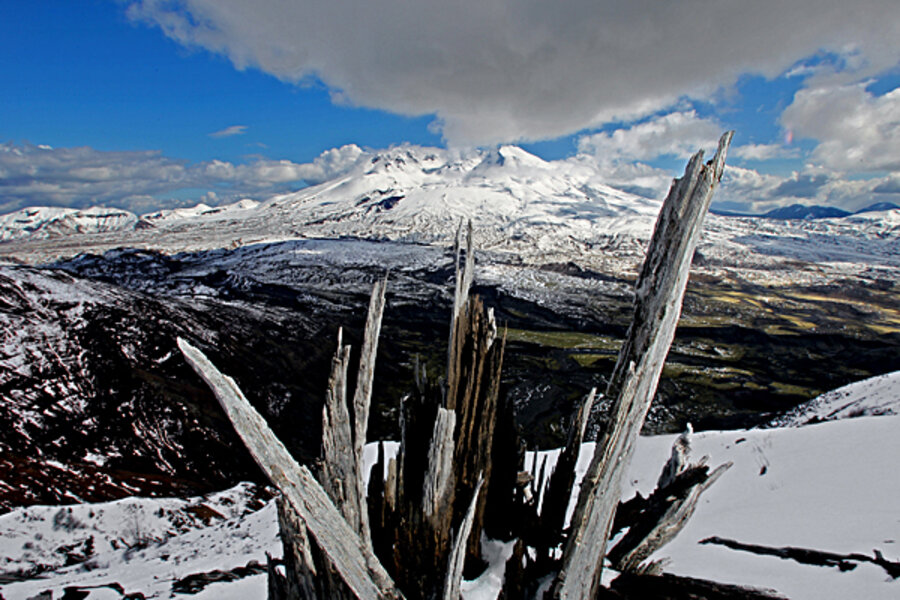Mt. St. Helens and the Cascade Volcanic Arc: Iceland in America
Loading...
The 30-year anniversary of the eruption of Mt. St. Helens arrives today as both a moment of reflection and a poignant reminder.
Mt. St. Helens struck a nation that – at least in its 48 contiguous states – often sees volcanic eruptions as exotic events on civilization’s fringe, the narratives of Hawaiians and Icelanders and (more recently) Europeans stranded in shuttered airports.
Yet America has its own Iceland, in some respects. It is called the Cascade Volcanic Arc, running from northern California through Washington State, and the eruption of Mt. St. Helens on May 18, 1980, was just a taste of what it can do.
IN PICTURES: Volcanoes around the world
The dynamics of the region’s tectonics make the Cascades and Iceland different. The Cascades, for one, are far less active. But each Cascades eruption has the potential to be far more explosive – as was demonstrated by Mt. St. Helens.
Mt. St. Helens vs. Eyjafjallajökull
The reason is that, geologically speaking, Iceland is set to simmer. New earth is constantly bubbling up through the rift that runs across the island and separates the North American and Eurasian tectonic plates. The function of Iceland’s volcanoes is essential to perpetually replenish the earth’s crust with new magma, which cools into rock.
Beneath the Cascades, however, the opposite is happening. The San Juan de Fuca tectonic plate is actually sliding beneath the North American plate and melting as it is driven into the earth. The melting rock then rises and occasionally explodes with tremendous force through the volcanoes of the Cascade Volcanic Arc.
Mt. St. Helens and its Cascades brethren are, in effect, the release valve for the pent up forces of tectonic cannibalism.
As if to send a small reminder of this fact, a swarm of small earthquakes recently hit Oregon’s Mt. Hood, suggesting the subterranean movement of magma. “These swarms are relatively common, but still worth watching,” writes geologist Erik Klemetti on his Eruptions blog.
Mt. Hood is only one of the Cascades’ several iconic stratovolcanoes – symmetrical cones that tower above the landscape and dominate the horizons of the American Northwest.
The big one: Mt. Rainier
Most prominent among them is Washington State’s Mt. Rainier, the hunched shoulder of snow and rock 54 miles southeast of Seattle. It is a potential Mt. Rainier eruption that poses the greatest threat to the Northwest, say scientists.
Atop the 14,411-foot peak lie 26 major glaciers, making it the most glaciated peak in the Lower 48 states. That is significant because the greatest threat posed by volcanoes in the Cascades is not so much the eruption itself, but the slurry of ice and rock that it sends hurtling down its mountainside. These lahars are the consistency of wet concrete, scalding hot, and on the steep slopes of Mt. Rainier, could travel at highway speeds.
Indeed, Mt. Rainier provides the perfect runway for these massive mudslides. From base to summit-top crater, Mt. Rainier is taller than the K2, the second-highest mountain in the world, which gets a huge upward boost from the Himalayan plateau.
In one Mt. Rainier eruption more then 5,000 years ago, these flows traveled with such speed and force that they ran into Puget Sound, reshaping the geography of the bay.
The last major eruption in the Cascades before Mt. St. Helens, however, was at California’s Lassen Peak from 1914 to 1917. Ash from the most forceful eruption, in 1915, landed in Nebraska.
Another California stratovolcano, Mt. Shasta, apparently erupted last in 1786 – an event reputedly seen by the French explorer Jean-François de Galaup La Pérouse from his ship in the Pacific, though some historians doubt this account.
Related:





